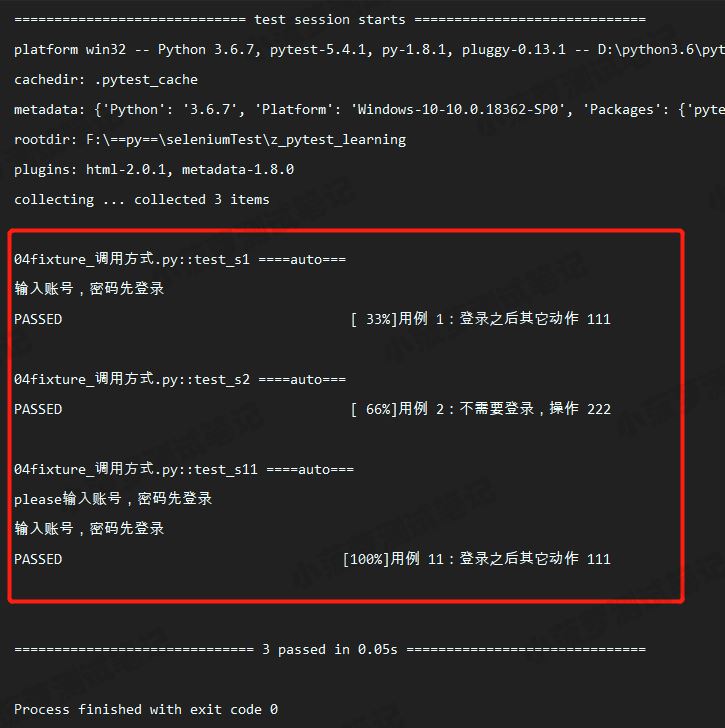前言
前面一篇讲了setup、teardown可以实现在执行用例前或结束后加入一些操作,但这种都是针对整个脚本全局生效的
如果有以下场景:用例 1 需要先登录,用例 2 不需要登录,用例 3 需要先登录。很显然无法用 setup 和 teardown 来实现了fixture可以让我们自定义测试用例的前置条件fixture优势
- 命名方式灵活,不局限于 setup 和teardown 这几个命名
- conftest.py 配置里可以实现数据共享,不需要 import 就能自动找到fixture
- scope="module" 可以实现多个.py 跨文件共享前置
- scope="session" 以实现多个.py 跨文件使用一个 session 来完成多个用例
fixture参数列表
@pytest.fixture(scope="function", params=None, autouse=False, ids=None, name=None)
def test():
print("fixture初始化的参数列表")参数列表
- scope:可以理解成fixture的作用域,默认:function,还有class、module、package、session四个【常用】
- autouse:默认:False,需要用例手动调用该fixture;如果是True,所有作用域内的测试用例都会自动调用该fixture
- name:默认:装饰器的名称,同一模块的fixture相互调用建议写个不同的name
注意
session的作用域:是整个测试会话,即开始执行pytest到结束测试
测试用例如何调用fixture
- 将fixture名称作为测试用例函数的输入参数
- 测试用例加上装饰器:@pytest.mark.usefixtures(fixture_name)
- fixture设置autouse=True
#!/usr/bin/env python # -*- coding: utf-8 -*- """ __title__ = __Time__ = 2020-04-06 15:50 __Author__ = 小菠萝测试笔记 __Blog__ = https://www.cnblogs.com/poloyy/ """ import pytest # 调用方式一 @pytest.fixture def login(): print("输入账号,密码先登录") def test_s1(login): print("用例 1:登录之后其它动作 111") def test_s2(): # 不传 login print("用例 2:不需要登录,操作 222") # 调用方式二 @pytest.fixture def login2(): print("please输入账号,密码先登录") @pytest.mark.usefixtures("login2", "login") def test_s11(): print("用例 11:登录之后其它动作 111") # 调用方式三 @pytest.fixture(autouse=True) def login3(): print("====auto===") # 不是test开头,加了装饰器也不会执行fixture @pytest.mark.usefixtures("login2") def loginss(): print(123)执行结果

fixture的实例化顺序
- 较高 scope 范围的fixture(session)在较低 scope 范围的fixture( function 、 class )之前实例化【session > package > module > class > function】
- 具有相同作用域的fixture遵循测试函数中声明的顺序,并遵循fixture之间的依赖关系【在fixture_A里面依赖的fixture_B优先实例化,然后到fixture_A实例化】
- 自动使用(autouse=True)的fixture将在显式使用(传参或装饰器)的fixture之前实例化
#!/usr/bin/env python # -*- coding: utf-8 -*- """ __title__ = __Time__ = 2020-04-06 16:14 __Author__ = 小菠萝测试笔记 __Blog__ = https://www.cnblogs.com/poloyy/ """ import pytest order = [] @pytest.fixture(scope="session") def s1(): order.append("s1") @pytest.fixture(scope="module") def m1(): order.append("m1") @pytest.fixture def f1(f3, a1): # 先实例化f3, 再实例化a1, 最后实例化f1 order.append("f1") assert f3 == 123 @pytest.fixture def f3(): order.append("f3") a = 123 yield a @pytest.fixture def a1(): order.append("a1") @pytest.fixture def f2(): order.append("f2") def test_order(f1, m1, f2, s1): # m1、s1在f1后,但因为scope范围大,所以会优先实例化 assert order == ["s1", "m1", "f3", "a1", "f1", "f2"]执行结果
断言成功
关于fixture的注意点
添加了
@pytest.fixture,如果fixture还想依赖其他fixture,需要用函数传参的方式,不能用@pytest.mark.usefixtures()的方式,否则会不生效@pytest.fixture(scope="session") def open(): print("===打开浏览器===") @pytest.fixture # @pytest.mark.usefixtures("open") 不可取!!!不生效!!! def login(open): # 方法级别前置操作setup print(f"输入账号,密码先登录{open}")前面讲的,其实都是setup的操作,那么现在就来讲下teardown是怎么实现的
用fixture实现teardown并不是一个独立的函数,而是用 yield 关键字来开启teardown操作
#!/usr/bin/env python # -*- coding: utf-8 -*- """ __title__ = __Time__ = 2020-04-06 15:50 __Author__ = 小菠萝测试笔记 __Blog__ = https://www.cnblogs.com/poloyy/ """ import pytest @pytest.fixture(scope="session") def open(): # 会话前置操作setup print("===打开浏览器===") test = "测试变量是否返回" yield test # 会话后置操作teardown print("==关闭浏览器==") @pytest.fixture def login(open): # 方法级别前置操作setup print(f"输入账号,密码先登录{open}") name = "==我是账号==" pwd = "==我是密码==" age = "==我是年龄==" # 返回变量 yield name, pwd, age # 方法级别后置操作teardown print("登录成功") def test_s1(login): print("==用例1==") # 返回的是一个元组 print(login) # 分别赋值给不同变量 name, pwd, age = login print(name, pwd, age) assert "账号" in name assert "密码" in pwd assert "年龄" in age def test_s2(login): print("==用例2==") print(login)yield注意事项
- 如果yield前面的代码,即setup部分已经抛出异常了,则不会执行yield后面的teardown内容
- 如果测试用例抛出异常,yield后面的teardown内容还是会正常执行
yield+with的结合
# 官方例子 @pytest.fixture(scope="module") def smtp_connection(): with smtplib.SMTP("smtp.gmail.com", 587, timeout=5) as smtp_connection: yield smtp_connection # provide the fixture value该
smtp_connection连接将测试完成执行后已经关闭,因为smtp_connection对象自动关闭时,with语句结束。addfinalizer 终结函数
@pytest.fixture(scope="module") def test_addfinalizer(request): # 前置操作setup print("==再次打开浏览器==") test = "test_addfinalizer" def fin(): # 后置操作teardown print("==再次关闭浏览器==") request.addfinalizer(fin) # 返回前置操作的变量 return test def test_anthor(test_addfinalizer): print("==最新用例==", test_addfinalizer)注意事项
如果 request.addfinalizer() 前面的代码,即setup部分已经抛出异常了,则不会执行 request.addfinalizer() 的teardown内容(和yield相似,应该是最近新版本改成一致了)
可以声明多个终结函数并调用总结
到此这篇关于Pytest框架之fixture的详细使用教程的文章就介绍到这了,更多相关Pytest fixture使用内容请搜索python博客以前的文章或继续浏览下面的相关文章希望大家以后多多支持python博客!
-
<< 上一篇 下一篇 >>
标签:pytest
Pytest框架之fixture的详细使用教程
看: 1550次 时间:2020-07-24 分类 : python教程
- 相关文章
- 2021-12-20Python 实现图片色彩转换案例
- 2021-12-20python初学定义函数
- 2021-12-20图文详解Python如何导入自己编写的py文件
- 2021-12-20python二分法查找实例代码
- 2021-12-20Pyinstaller打包工具的使用以及避坑
- 2021-12-20Facebook开源一站式服务python时序利器Kats详解
- 2021-12-20pyCaret效率倍增开源低代码的python机器学习工具
- 2021-12-20python机器学习使数据更鲜活的可视化工具Pandas_Alive
- 2021-12-20python读写文件with open的介绍
- 2021-12-20Python生成任意波形并存为txt的实现
-
搜索
-
-
推荐资源
-
Powered By python教程网 鲁ICP备18013710号
python博客 - 小白学python最友好的网站!